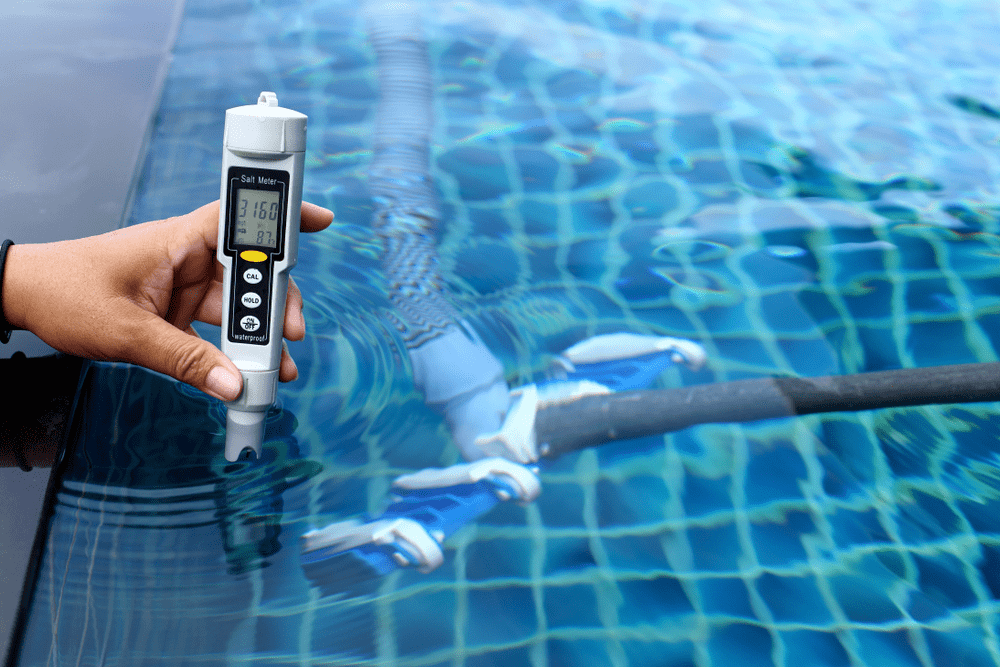1. How Temperature & Debris affect Pool Closing
Most people close their pools when the kids go back to school or by the end of September. When temperatures stay below 65°F (18°C) during the daytime (off-season) and frost at night, it is time to close your pool. Pool closing TIP: Closing too early will allow algae to grow and cause a troublesome pool opening in the Spring.
Why does algae bloom? Algae needs sunlight and heat to thrive. Cold temperatures help keep your water clear of algae. As a bonus, leaving your pool open longer with cold weather allows the opportunity to clean your pool, test for pool balance, and balance your pool before closing.
For those in a treed area, closing might be earlier if the leaves are falling heavily and are polluting the pool.
2. What are the best pool closing chemicals
Test the water yourself with test strips or liquid test kits. If there is a SERIOUS concern, take a water sample to your local pool store and have them test it for you. You are concerned about pH above 8.0 and below 5.0 and extreme alkalinity readings that you cannot control.
Otherwise, you should be able to handle everything yourself. The pH should be between 7.2 and 7.6, and alkalinity between 100 ppm and 150 ppm. Calcium hardness range from 175 ppm to 225 ppm. Chlorine between 1 ppm and 3 ppm. If you use a different sanitizer, such as bromine, just make sure it’s at the proper level. Since you won’t be adjusting the water balance during the offseason, it’s better to be on the high side of these ranges when you close your pool because they’ll naturally decrease over time. This cuts done pool opening maintenance.
Increase alkalinity by adding sodium bicarbonate to your pool water. Reduce alkalinity with muriatic acid. Adjust alkalinity before pH because it has an impact on pH readings. Ensure that a pH target of 7.2 is met. Pool closing TIP: Raising or lowering the pH is using the same chemicals as adjusting the alkalinity. Raise the pH with soda and lower with acid. It's a balance of pH and alkalinity. That's why they call it pool balance.
Hard water (typically from well water) typically deposits calcium and iron molecules in your pool and plumbing, forming a build-up over time. Too-soft water can also corrode metal.
If your water’s too hard, add salt. Too soft, add calcium chloride.
Another pool closing TIP: When using calcium hypochlorite or tri-chlor pucks, use fast-acting pucks that dissolve within 24 hours. Alternatively, use up your supply of liquid chlorine (sodium hypochlorite) as to not have to store it over winter. Using triple the normal amount will have no negative effect.
Add C-Poolandspa CLEAN & CLEAR or an algaecide to your pool just before closing it to keep algae from invading over the winter. Especially when the cover is on and you can't treat the water.
Also add (optional) a clarifying enzyme treatment ( such as C-Spa Non-foaming Enzymes) to further retard algae growth, liner stains, and contaminant build-up. Add a few capfuls to the water, where they work all winter to help you greet spring with a clear pool. If you’ve struggled with a green, murky pool at the opening in the past, or want to avoid one in the future, using C-Poolandspa CLEAN & CLEAR and C-Spa can help immensely.
3. Pool Closing Cleaning Tips
It is the final cleaning of the season, so make it thorough. Contaminants sitting on the bottom can decompose over the winter and feed algae and reduce chlorine effectiveness. Vacuum the entire pool, brush down the walls, and skim the surface. Keep the filter running to clarify the water. Allow time for the chlorine to attack the contaminants. Brush out any algae from the vinyl seats, stairs, and walls. A little prep now will save you from some potentially nasty surprises when you open your pool next spring. A clean pool makes it easier to properly balance your water. It also ensures nothing is left behind to feed algae or mold that might develop over winter. I recommend a super dose of liquid chlorine. It will not evaporate as fast in the darker, cold weather.
4. Drain and Filters danger
Water trapped in your pool lines can damage the lines by ice expansion. Even if winters are mild in your area, draining or blowing the lines is essential. Simply drain the pool down to below the return jets, PLUG the jets. Using gavity, allow all the water to drain throughout the system and the filter and pump (assuming they are the lowest point). If not, blow the lines to remove water. Open up all the valves to allow for drainage. Plug the skimmer. Open the drain valve on the filter. If it is an easy disconnect, remove the pump and store indoors. If not, ensure no water is trapped inside the pump.
5. Protect Skimmer
Remove the skimmer basket and store it somewhere safe and dry for the winter. Insert a skimmer plug after the pool has been drained to the desired level.
6. Winterizing The Pump to prevent damage
The Pump:
Pool closing requires that you completely remove all drain plugs to drain and remove the pool pump if able. If not, ensure there is no trapped water by opening the pump drains or by cracking open the pump mechanism from the motor itself. Store all the drain plugs (including the ones from the filter) in the pump basket so that you keep them all together and you won’t have to go hunting for them in the spring.
The Filter:
Sand: The first thing you should do when closing your pool and winterizing your sand filter system is to perform a backwash. After the water is running clear from the nozzle, turn off the power. After you backwash, move the valve to the “rinse” position and let it run for 30 seconds. After a backwash and rinse, place the valve to the “winterize” (opens valves) setting on the top mount valve. This will allow water to drain from the valve. Next, Completely drain all the water from the filter tank. Unscrew and remove the drain cap on the bottom of the filter barrel. Put the cap away in the pump baskets. You do not need to remove any sand from the filter. Your sand filter system‘s sand is good for about 4-5 years.
Sand: Set your multiport valve to “Winterize,” and remove the drain plug at the bottom to allow the filter to drain completely. If your multiport valve has a bleeder valve and a sight glass, remove those too, and store them in the pump basket for easy retrieval next season.
At pool closing, consider bringing your filter indoors for winter storage. If the weight of the sand makes this too difficult, you can leave it outside if you remove all the drain plugs. With the plugs removed, freezing water or condensation that builds up inside the filter tank won’t crack it.
Diatomaceous Earth (D.E.): Drain it, then rinse off the grids (or fingers) with a hose to remove excess D.E. Leave the valves open. Otherwise, similar to sand filters.
Cartridge Drain it, then rinse off the cartridge with a hose. Leave the valves open, and store the cartridge(s) indoors for the winter. Pool closing TIP: Always have a backup cartridge in the event of a tear or rip.
Pool Closing TIP: Move your hardware indoors or have a protective cover after you disconnect. It extends your gear’s useful life and protects it from cold weather damage.
SALTWATER Pool CLosing: If your pool uses a saltwater system, switch the chlorine generator to the “winter” setting, if it has one. If it doesn’t, most chlorine generators have a removable electrolytic cell you can access by unscrewing the end caps. Remove the cell, or your entire salt system if you prefer, and store it inside for the winter.
Saltwater Pool TIP: Take a few moments to clean the cell before storing it. It’ll prolong its life and help reduce the risk of hardware problems when it’s time to reopen your pool. Flip the circuit breaker and make sure power and gas to the heater are off. Then store any controllers, robotic cleaners, and other electronics indoors for the winter.
7. Accessories and Pool Closing
Gather up your pool ladder, floaters, toys, and any other accessories you may have. Leaving them in the pool can damage the items or, even worse, your pool. They could puncture the lining or start to rust. Corroded metal can contaminate your water and cause serious hardware problems.
Gather up all your accessories, then give them a good cleaning and let them dry. Then store them in a clean, dry place, away from direct sunlight, until spring.
8. Lower Water, but not too much
Closing your pool requires that you pool water well below the skimmer and to at least one inch below the return jets port. This allows you to drain the lines. Plug the port(s) snugly by screwing in the correct cap on each exposed port. Do not allow any water back into the lines as it will freeze and crack the lines. Closing TIP: For those with safety covers, don't remove too much water or the weight of the snow will stretch the cover and pop the anchor plugs of the cover.
9. Air Pillow
In cold climates, placing an air pillow under the cover protects the walls of your pool from damage. It compensates for the pressure of the snow and ice on top of the cover. A few pillows are essential is you are using a POOL SAFETY COVER because it keeps the cover level and allows leaves and snow to blow off.
Pool Closing TIP: Pool covers are ideal to keep water and debris off of the pool surface to the side of the pool for an easy spring clean-up.
10. Pool Covers and Pool Closing
Place the pool cover over your pool—and the air pillow. Bricks, stones, or anything else may damage your liner if it were to fall into the pool. Keep the cover dry. Pool safety covers are recommended for families with children and pets because they will not sink, collapse, or rip in the event that someone accidentally walks on them or a pet runs over them.










